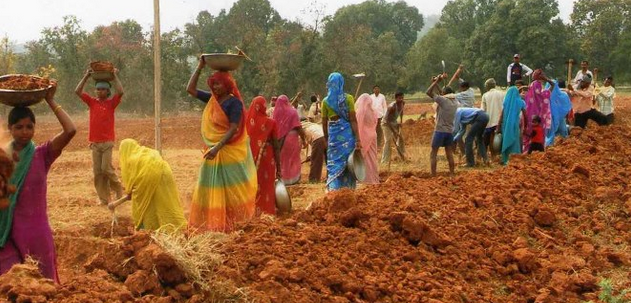On December 13, in the Rajya Sabha during the ongoing winter parliamentary session, Mallikarjun Kharge raised questions regarding beneficiaries who come under the Scheduled Caste (SC) and Scheduled Tribes (ST) category for the MGNREGA scheme. Kharge has been serving as the president of the Indian National Congress since 2022 and is a member of parliament from Karnataka since 2020. These questions were asked to Sadhvi Niranjan Jyoti in the Rajya Sabha. Jyoti is currently serving as the minister of state in the ministry of rural development.
The Mahatma Gandhi National Rural Employment Guarantee Act (MGNREGA) is a scheme to provide employment in rural areas. The objective of the scheme is to provide 100 days of guaranteed wage employment to rural unskilled labour. The reference to person-days in the tables given below refers to the total number of workdays by a person registered under the scheme in a financial year.
The table provided above shows the details of total Persondays generated, Scheduled Castes (SCs) Persondays generated and its percentage under Mahatma Gandhi NREGS from 2014-15 to current financial year 2023-24 (as on December 7, 2023). We can see that the percentage of SCs Persondays generated has been gradually decreasing from 22.63% in 2014-15 to 19.39% in 2023-24. The highest total Persondays generated was 388.89 crores in 2020-21. This year also saw the highest amount of SCs Persondays generation equal to 77.27 crores.
The table given above shows the details of Scheduled Castes (SCs) households availed employment against, total households availed employment and its percentage under Mahatma Gandhi NREGS from financial year 2014-15 to current financial year 2023-24 (as on December 7, 2023). From the data, it can be deduced that there have been various fluctuations from 2014-15 till 2023-24. The highest percentage of SC households that availed employment was 23% in 2015-16. The highest amount of employment total households availed was 754.73 lakhs in 2020-21. The same year also saw the highest amount of employment availed by SC households equivalent to 155.20 crores.
The table given above shows the details of Scheduled Tribes (STs) households availed employment against total households availed employment under Mahatma Gandhi NREGS from financial year 2014-15 to current financial year 2023-24 (as on December 7, 2023). A look at the data shows that there have been various fluctuations since 2014-15. Though we can also see that there has been a gradual increase in the percentage of employment availed by the ST households from 2021-22. The highest percentage generation of employment for ST households was 17.26% in 2014-15. The highest amount of employment total households availed was 754.73 lakhs in 2020-21. The same year also saw the highest amount of employment availed by ST households equivalent to 118.36 crores.
The highest total person-days and household employment availed were observed in 2020-21 for both SCs and STs. SC households availed more employment compared to ST households over the years, as indicated by the data. However, the decreasing trend in SCs person-days generated might signal a concerning aspect, requiring a closer examination of the reasons behind this decline. Addressing this decline could be pivotal in ensuring equitable employment opportunities for SCs under the MGNREGA scheme.
The complete answer can be read here:
Related:
Union data on faculty position in Central University: 14.3% SC, 7% ST, 23.4% OBC
Parliamentary inquiry unveils 165 data breaches from 2018-23 as reported by CERT-In



